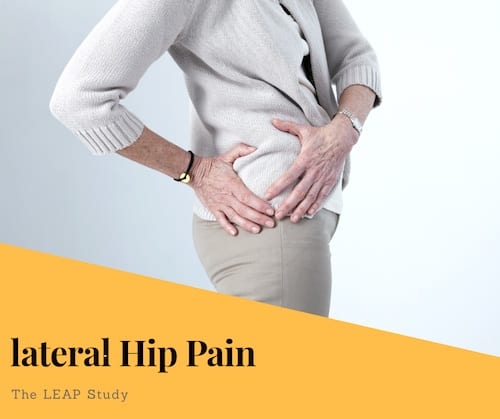
Lateral hip pain is a painful and disabling condition. It affects 1 in 4 women over the age of 50 and can be as disabling as hip osteoarthritis. Lateral hip pain may be called several things by your hip physiotherapist including trochanteric bursitis, greater trochanteric pain syndrome or gluteal tendinopathy.
The onset of pain is often insidious without any identifiable trauma or provocative activities. The pain is usually over the outer hip and can travel down the leg. You are unable to lie on the hip and find sleep is severely affected. Physical activity such as walking, climbing stairs and squatting increases the pain.
The team at Coastal Physiotherapy are constantly modifying treatment approaches to improve patient outcomes. One study that has come to our attention and changing the management of lateral hip pain, is the LEAP study. The study looked at three groups, being an eight-week hip physiotherapy program, corticosteroid injection, or the control group with no treatment.

The hip physiotherapy group reported a 77.3% overall improvement. This was significantly better than the corticosteroid group who reported a 58% overall and improvement and a 29.4% improvement when no treatment was given.
What was included in the physiotherapy program to achieve better results:
- Education: The lateral hip structures are compressed when the leg crosses the midline. This is called adduction of the hip. Education focused on avoiding adduction positions. This meant sitting with the legs straight rather than crossed. Avoiding side lying sleeping and using pillows between the knee.
- Gentle low load exercise: Exercise is initially slow and gentle. As the pain settles the resistance and speed of exercise is increased.
- Progression to Functional exercise: Functional exercises include squats and steps ups. These exercises are aimed at ensuring the lower legs remain in good alignment to reduce pain. This also gives the participants the skills to ensure they can move throughout the day without pain.
Its great to see that research studies are demonstrating the effectiveness of physiotherapy for the hip. It also supports the decisions to avoid painful injections that have side effects and are not as effective as exercise. Even better is that the participant showed continued improvements 12 months later.
Mellor Et. Al 2018 “Education plus exercise versus corticosteroid injection use Versus a wait and see approach on global outcome and pain from gluteal tendinopathy: a prospective, single-blinded, randomised clinical trial”. BMJ 361.
Craig Paulsen
